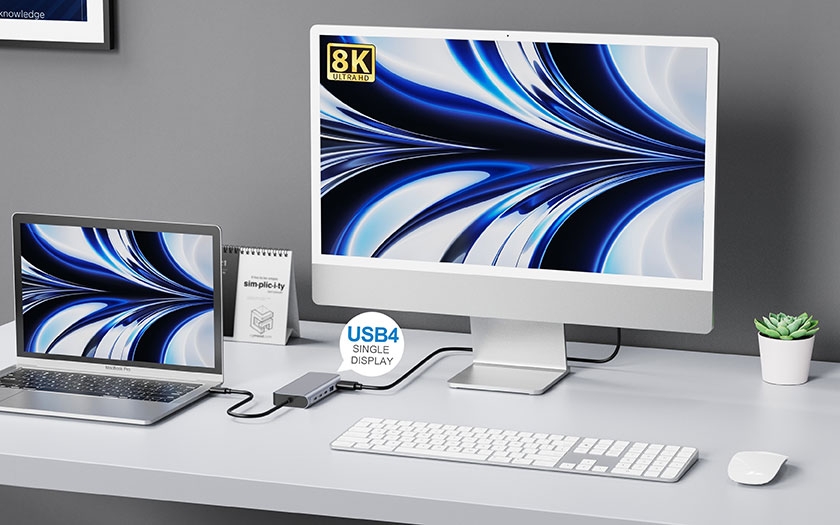The Universal Serial Bus, or USB connector has come a long way since its humble origins as a better port for plugging your mouse or printer into your PC. Now, the latest generation of the technology standard, USB4, is starting to show up in the wild.
In Nov. 2020, Apple unveiled a portfolio of new MacBook that feature USB4 ports as it transitioned to computers running its homegrown M1 Apple Silicon chips. USB4 is also coming to the Windows world as Intel's Tiger Lake chips roll out.

USB4 is a USB system specified in the USB4 specification which was released in version 1.0 on 29 August 2019 by USB Implementers Forum. USB4 is the latest USB standard based on the Thunderbolt 3 specification. As such, it works for everything from displays and power cables to storage devices.
USB4 is capable of up to 40 Gbps. That's also four times the speed of the far more common USB3.1 (3.2 gen. 2) and eight times as fast as USB 3.0 (3.2 gen. 1). Fullink 1170 is USB4 full-functional 8K cable with Aluminum Housing, it can drive one 8K@60Hz display, data transfer up to 40Gbps and power delivery up to 100W.

USB4 exclusively use Type C, also known as USB-C or USB Type-C. USB-C specifies a centrally located 24-pin connector with 12 A pins on top and 12 B pins at the bottom. With two lanes of differential SuperSpeed pairs, USB4 supports a max bandwidth of 20 Gbps per lane. Additionally, you no longer need to worry about the correct orientation either, as the pins are symmetrical on both sides.
With USB PD (Power Delivery) USB 3.2 Gen 2 offers up to 20 volts of power at 5 A for a potential total of 100 W. USB4 takes this even further. USB4 can support up to 100W (20V/5A) in the standard power range, but it can also support up to 240 W (48V/5A) in the extended power range, which allows it to power way more devices.
USB doubled the data transfer rates with each version, and USB4 followed the same pattern as well. Under ideal conditions, USB3.0, 3.1, and 3.2 could theoretically support data transfer speeds of up to 5, 10, and 20 Gbps, respectively. While USB4 is marketed as having a 40 Gbps max transfer rate, the reality is a bit more nuanced.
That combination of high data throughput and power delivery means it can act as a singular cable for displays. It can handle two 4K displays or one 5K display over a single connector. It also has enough data throughput to connect external graphics cards to desktops and laptops.

USB 4 supports older USB devices, as long as they fit into the port. If they don’t, consider buying a converter. You’ll just need to know if your older USB tech uses a USB-A or USB-C design.
Of course, to take advantage of USB4 devices, you'll need a computer that has USB4, and at the moment the only computers that support USB4 are modern Apple desktops and laptops, as well as some Intel-based laptops and desktop motherboards. Some devices won't mention support for USB4 but will mention Thunderbolt 4. If a port supports Thunderbolt 4, that means it's USB4, but not all USB4 ports are Thunderbolt 4 ports.
USB4 is largely based on Thunderbolt 3, which is basically a special version of USB that has way more bandwidth than the normal version. Thunderbolt 3 (which has since been succeeded by Thunderbolt 4) was used in external SSDs, external GPUs, and docking stations because it provided direct access to four PCIe lanes. Without those lanes, external NVMe SSDs and eGPUs wouldn't have worked.

But USB4 doesn't have to perform as well as Thunderbolt 3; manufacturers are allowed to only offer 2 of those PCIe lanes or 20 Gbps, which means support for Thunderbolt 3 devices isn't a given. Compared to Thunderbolt 4, USB4 is also missing dual monitor support, so even if your PC has the best possible USB4 port, it still won't be quite as good as Thunderbolt.
A USB-C is a type of cable, while USB4.0 is a specific version of the USB cable technology. USB4 has nothing to do with the shape. It's referring to the specific tech that's inside a USB-C. That's right – your cable could have both USB-C and USB4.
USB4 tops out at 40 gigabits per second, twice the speed of the latest version of USB3 and 8 times the speed of the original USB3 standard, which was of course itself way faster than what it was replacing. It'll also support the max speed of previous cables and interfaces. Universal Thunderbolt 3 compatibility.
USB4 specifies the USB-C connector type. Thanks to USB4's backward compatibility, you can plug a USB3 cable into a USB4 port as long as the form factor is USB-C. If it's a different connector such as Type-A or Micro-B, they won't physically fit in the first place.
In short, USB 4 is the next iteration of the USB protocol, which was first released in 2019. It's based on the Thunderbolt 3 protocol, and its main benefits include faster transfer speeds, DisplayPort 2.0 compatibility, and optional Thunderbolt 3 compatibility.